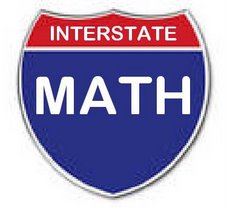************************
From FOCUS [The Newsletter of the Mathematical Association of America], February 2007, Volume 27, Number 2, pp. 27-28. See http://www.maa.org/pubs/focus.html . The articles are posted with the approval of the Editor of FOCUS.
----------------------------------------
This is the FIRST of three articles that appeared in the current issue of FOCUS dealing with NCTM's Curriculum Focal Points. The other two articles will follow shortly.
************************
In FOCUS: Curriculum Focal Points
As noted in our November issue, the National Council of Teachers of Mathematics (NCTM) recently released a document entitled Curriculum Focal Points. The document is available online at http://www.nctm.org/focalpoints/downloads.asp, where one can also find a lot more information and discussion, including questions and answers on the document. NCTM says the document extends the Council's leadership of more than twenty-five years by describing an approach to curriculum development that focuses on areas of emphasis within each grade from prekindergarten through grade 8. Curriculum Focal Points, widely reported in the news media, was hailed by some as a retreat from NCTM's previous positions. This misreading is addressed in each of the three articles that follow. We hope that they will shed some light on the goals and content of Curriculum Focal Points. The articles below are the opinions of the authors and do not reflect a position or stance of the MAA.
NCTM's Curriculum Focal Points
By Francis (Skip) Fennell
The publication by the National Council of Teachers of Mathematics (NCTM) of Curriculum Focal Points for Prekindergarten through Grade 8 Mathematics: A Quest for Coherence marks the Council's next step in implementing the vision set forth in the Principles and Standards for School Mathematics (NCTM, 2000), with a particular emphasis on curricular expectations.
The genesis of the Curriculum Focal Points, released on September 12, 2006, was a conference at the Park City Mathematics Institute in 2004 organized by NCTM with the Association of State Supervisors of Mathematics (ASSM). It brought together mathematicians, supervisors of mathematics, and mathematics educators with the intent to examine the K-12 mathematics standards of each of the states and how they were influenced by Principles and Standards for School Mathematics. The expectation was that the consistency of the findings would guide a discussion that could begin to lead to a meeting of the minds about the important mathematics that should be taught at various grades. Instead, the outcome was the discovery that there was little consistency between standards and expectations or of what content fell in what grade, and perhaps most troubling was the consequent realization that this lack of consistency was inevitably detrimental to the teaching and learning of K-12 mathematics nationwide.
An analysis of the conference findings resulted in the publication entitled "Standards and Curriculum: A View from the Nation," (NCTM, 2005). This joint report by NCTM and ASSM provides insights into where we appear to be headed in our expectations for students' mathematics learning. The report is an initial attempt to examine across states the impact of Principles and Standards for School Mathematics on curriculum reform, discern how state educational agencies approached the task of developing state standards, and bring to light areas of commonality and difference. The findings from this endeavor laid a foundation for discussions about the future direction of local, state, and national mathematics curricula. From this were born the idea and concept of what became the Curriculum Focal Points.
Extensive, thoughtful, and at times intensely debated discussions among a group of nine writers generated the concept and early drafts of the curriculum focal points. The written draft of the writers, who represented expertise in mathematics and mathematics education as well as classroom experience from prekindergarten through grade 8, was reviewed and commented upon by some 70 reviewers, including mathematicians, mathematics educators, and policy makers. After extensive further revisions, the publication was presented to the NCTM Board of Directors, which on April 24, 2006 approved it for publication.
Curriculum focal points are important mathematical topics for each grade level. They are the related ideas, concepts, skills, and procedures that form the foundation for understanding, lasting learning, and success in higher level mathematics, beginning with algebra. NCTM views the Curriculum Focal Points as a framework for developing mathematics curriculum at the state and school district level. The focal points are intended to frame discussions that will eventually inform the decisions of textbook publishers and assessment developers, as well.
The Curriculum Focal Points address curriculum, or what is taught, rather than instruction, or how it is taught. By design, there is no mention of instructional strategies, instructional materials, technological tools (e.g. the calculator), or manipulative materials. This was the intent of the writers of the focal points-to provide a publication that would foster discussion, dialogue, and decision-making relative to the important mathematics for prekindergarten through grade 8. The ultimate goal would be for these suggestions, the focal points, to lead to the development of mathematics curriculum goals that are more cohesive from grade to grade and from school to school. Through its Connections, the new publication also shows additional ways in which the focal points connect to Principles and Standards.
The Curriculum Focal Points provides an example, a critical foundation, for the next generation of curricula and related assessments. Curriculum developers can place Curriculum Focal Points and a local or state curriculum side by side when refining their current curricula. Curriculum developers can determine how much time to devote to the focal points as the mathematical core for a particular grade level, and then build other mathematics topics around these important areas of focus.
Media Coverage
The Curriculum Focal Points release was widely reported in the news media and generated considerable discussion within the mathematics and education communities. Some inaccurate coverage raised questions among many who were asking "Is what the Wall Street Journal and New York Times reported true? Is NCTM really going back to basics?"
In a letter sent to the Wall Street Journal and published on September 26, I wrote, "Contrary to the impression left in your article, learning the basics is certainly not 'new marching orders' from the NCTM, which has always considered the basic computation facts and related work with operations to be important. Nor is the new focal-points approach to curriculum development a 'remarkable reversal' for NCTM. As stated in NCTM's 1989 and 2000 standards, conceptual understanding and problem solving are absolutely fundamental to learning mathematics. The council has never promoted estimation 'rather than precise answers.' Estimation is a critical component to the overall understanding and use of numbers."
A letter to the editor of the New York Times published on September 24, stated, "What some refer to as basic skills (for example, multiplication facts, and fluency with the addition, subtraction, multiplication and division of whole numbers) have always been a fundamental core of elementary school mathematics. Always. But we want more. We want children to understand the mathematics they are learning and we want them to be able to solve problems, which is, in the long run, why we do mathematics."
The Curriculum Focal Points are in no way a reversal of the Council's long-standing position on teaching students to learn critical foundational topics (e.g. multiplication) with conceptual understanding, and they are not a retreat from Principles and Standards for School Mathematics. Rather, the Curriculum Focal Points are the next step in implementing the Standards. The appendix in Curriculum Focal Points directly links the focal points to virtually all the expectations in Principles and Standards.
One of the questions asked most frequently is about the standard algorithm and whether the Curriculum Focal Points expressly states that all students must learn the standard algorithm. The grade 2 focal point suggests efficient procedures, including the standard algorithm-including, not exclusively, access to the standard algorithm. Students should use what they can do efficiently and accurately. Most important, they should not use any algorithm until it is understood.
Similarly, for grade 4 the quick recall of multiplication facts and fluency with efficient procedures, including the standard algorithm, is a focus. Again, and importantly, fluency emerges through deep understanding of the multiplication process-how multiplication is represented and how properties, particularly the distributive property, are used when multiplying. Students become fluent through their understanding of how and why procedures work - with a focus on place value and properties of operations.
The Purpose
Today's mathematics curricula tend to be dominated by long lists of very specific goals, standards, objectives, or learning expectations. By contrast, Curriculum Focal Points describes significant mathematical concepts and skills for each grade level. They are a way to organize and connect critical mathematics topics from grade to grade. Organizing a curriculum around the focal points can provide students with a more coherent ever expanding body of mathematical knowledge.
Mathematics leaders should use the Curriculum Focal Points to launch discussions about the next generation of curriculum standards, textbooks, and tests. Such dialogue, discussion, and debate is critical and can lead to the development of new models for curriculum, instruction, materials, and assessments. Curriculum Focal Points for Prekindergarten through Grade 8 Mathematics represents an important, initial step in advancing collaborative discussions about what mathematics students should know and be able to do.
Subscribe to:
Post Comments (Atom)


No comments:
Post a Comment